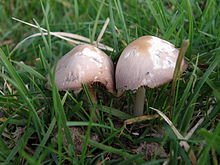- Conocybe rickenii
-
Conocybe rickenii Conocybe rickenii spore print and split cap. The cap is discoloured. Scientific classification Kingdom: Fungi Division: Basidiomycota Class: Agaricomycetes Subclass: Hymenomycetes Order: Agaricales Family: Bolbitiaceae Genus: Conocybe Species: C. rickenii Binomial name Conocybe rickenii
(Schaeff.) KühnerConocybe rickenii Mycological characteristics 
gills on hymenium 
cap is conical 
hymenium is adnate 
stipe is bare 
spore print is brown 
ecology is saprotrophic 
edibility: not recommended Conocybe rickenii is a mushroom from the genus Conocybe. Its edibility is disputed, and it has the appearance of a typical little brown mushroom with a small, conical cap, and long, thin stem. In colour, it is generally a cream-brown, lighter on the stem, and it has a thin layer of flesh with no distinct smell or taste. It is a coprophilous fungi, feeding off dung, and it is most common on very rich soil or growing directly from dung. It can be found in Europe, Australia and Pacific islands.
Contents
Taxonomy
C. rickenii was first described by Jacob Christian Schäffer and named Galera rickenii. It was reclassified by Robert Kühner, who placed it in the Conocybe genus.[1]
Description
C. rickenii has a conical cap of 1 to 2.5 centimetres (0.39 to 0.98 in) across, which is an ochre-brown, sometimes becoming a little more grey at the centre. The stem is typically 40 to 70 millimetres (1.6 to 2.8 in) in height, by 1 to 2 millimetres (0.039 to 0.079 in) in thickness, and is whitish cream, darkening to a dirty brown with age. The thin layer of flesh is grey-brown in the cap, while lighter in the stem. It has ochre-cream (later darkening to rusty-ochre) gills,[1] which are adnate,[2] leaving a brown spore print. The spores themselves are elliptic to oval, measuring between 10 and 20 micrometres (0.00039 and 0.00079 in) by 6 to 12 micrometres (0.00024 to 0.00047 in). It has two-spored basidia, and a cellular cap cuticle.[1]
It is generally a little larger than the slightly more common coprophilious C. pubescens,[3] while it can be differentiated from other dung-loving Conocybe by its two-spored basidia, large spores and the fact it does not have lecythiform caulocystidia.[4]
Edibility
British mycologist Roger Phillips lists the edibility as unknown,[1] while David Pegler considers it inedible.[2] The flesh has no distinct smell or taste.[1]
Distribution and habitat
C. rickenii grows on extremely rich soil, especially on dung and compost heaps.[1] It can be found in very large numbers in gardens where horse manure has been used to enrich the soil.[2] It can be found in Europe,[1] Australia,[5] and Pacific islands and the United States.[4]
References
- ^ a b c d e f g Phillips, Roger (1981). Mushrooms and Other Fungi of Great Britain and Europe. London: Pan Books. p. 154. ISBN 0330264419.
- ^ a b c Pegler, David N. (1983). Mushrooms and Toadstools. London: Mitchell Beazley Publishing. p. 162. ISBN 0855335009.
- ^ Pegler, 162
- ^ a b Hemmes, Don E.; Desjardin, Dennis E. (2002). Mushrooms of Hawai'i. Ten Speed Press. p. 56. ISBN 9781580083393. http://books.google.co.uk/books?id=xbEC2PrmZZkC&pg=PA56&dq=%22Conocybe+rickenii%22&lr=lang_en&as_drrb_is=q&as_minm_is=1&as_miny_is=2009&as_maxm_is=12&as_maxy_is=2009&as_brr=3&as_pt=ALLTYPES&client=firefox-a. Retrieved 29 March, 2009.
- ^ May, Tom. "Conocybe rickenii". Interactive Catalogue of Australian Fungi. Royal Botanic Gardens, Melbourne and Australian Biological Resources Study. http://www.rbg.vic.gov.au/dbpages/fungi/cat/details.php3?id=599. Retrieved 2009-03-29.[dead link]
Categories:- Bolbitiaceae
- Fungi of Europe
- Fungi of Oceania
- Fungi of North America
Wikimedia Foundation. 2010.



